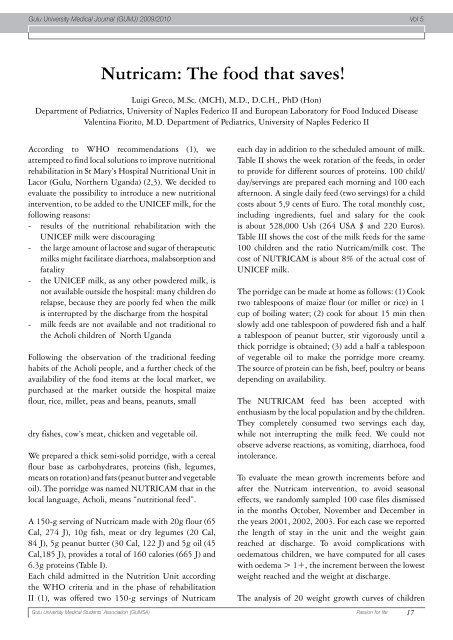GULU UNIVERSITY MEDICAL JOURNAL
GULU UNIVERSITY MEDICAL JOURNAL
GULU UNIVERSITY MEDICAL JOURNAL
You also want an ePaper? Increase the reach of your titles
YUMPU automatically turns print PDFs into web optimized ePapers that Google loves.
Gulu University Medical Journal (GUMJ) 2009/2010 Vol 5.<br />
Nutricam: The food that saves!<br />
Luigi Greco, M.Sc. (MCH), M.D., D.C.H., PhD (Hon)<br />
Department of Pediatrics, University of Naples Federico II and European Laboratory for Food Induced Disease<br />
Valentina Fiorito, M.D. Department of Pediatrics, University of Naples Federico II<br />
According to WHO recommendations (1), we<br />
attempted to find local solutions to improve nutritional<br />
rehabilitation in St Mary’s Hospital Nutritional Unit in<br />
Lacor (Gulu, Northern Uganda) (2,3). We decided to<br />
evaluate the possibility to introduce a new nutritional<br />
intervention, to be added to the UNICEF milk, for the<br />
following reasons:<br />
- results of the nutritional rehabilitation with the<br />
UNICEF milk were discouraging<br />
- the large amount of lactose and sugar of therapeutic<br />
milks might facilitate diarrhoea, malabsorption and<br />
fatality<br />
- the UNICEF milk, as any other powdered milk, is<br />
not available outside the hospital: many children do<br />
relapse, because they are poorly fed when the milk<br />
is interrupted by the discharge from the hospital<br />
- milk feeds are not available and not traditional to<br />
the Acholi children of North Uganda<br />
Following the observation of the traditional feeding<br />
habits of the Acholi people, and a further check of the<br />
availability of the food items at the local market, we<br />
purchased at the market outside the hospital maize<br />
flour, rice, millet, peas and beans, peanuts, small<br />
dry fishes, cow’s meat, chicken and vegetable oil.<br />
We prepared a thick semi-solid porridge, with a cereal<br />
flour base as carbohydrates, proteins (fish, legumes,<br />
meats on rotation) and fats (peanut butter and vegetable<br />
oil). The porridge was named NUTRICAM that in the<br />
local language, Acholi, means “nutritional feed”.<br />
A 150-g serving of Nutricam made with 20g flour (65<br />
Cal, 274 J), 10g fish, meat or dry legumes (20 Cal,<br />
84 J), 5g peanut butter (30 Cal, 122 J) and 5g oil (45<br />
Cal,185 J), provides a total of 160 calories (665 J) and<br />
6.3g proteins (Table I).<br />
Each child admitted in the Nutrition Unit according<br />
the WHO criteria and in the phase of rehabilitation<br />
II (1), was offered two 150-g servings of Nutricam<br />
each day in addition to the scheduled amount of milk.<br />
Table II shows the week rotation of the feeds, in order<br />
to provide for different sources of proteins. 100 child/<br />
day/servings are prepared each morning and 100 each<br />
afternoon. A single daily feed (two servings) for a child<br />
costs about 5,9 cents of Euro. The total monthly cost,<br />
including ingredients, fuel and salary for the cook<br />
is about 528,000 Ush (264 USA $ and 220 Euros).<br />
Table III shows the cost of the milk feeds for the same<br />
100 children and the ratio Nutricam/milk cost. The<br />
cost of NUTRICAM is about 8% of the actual cost of<br />
UNICEF milk.<br />
The porridge can be made at home as follows: (1) Cook<br />
two tablespoons of maize flour (or millet or rice) in 1<br />
cup of boiling water; (2) cook for about 15 min then<br />
slowly add one tablespoon of powdered fish and a half<br />
a tablespoon of peanut butter, stir vigorously until a<br />
thick porridge is obtained; (3) add a half a tablespoon<br />
of vegetable oil to make the porridge more creamy.<br />
The source of protein can be fish, beef, poultry or beans<br />
depending on availability.<br />
The NUTRICAM feed has been accepted with<br />
enthusiasm by the local population and by the children.<br />
They completely consumed two servings each day,<br />
while not interrupting the milk feed. We could not<br />
observe adverse reactions, as vomiting, diarrhoea, food<br />
intolerance.<br />
To evaluate the mean growth increments before and<br />
after the Nutricam intervention, to avoid seasonal<br />
effects, we randomly sampled 100 case files dismissed<br />
in the months October, November and December in<br />
the years 2001, 2002, 2003. For each case we reported<br />
the length of stay in the unit and the weight gain<br />
reached at discharge. To avoid complications with<br />
oedematous children, we have computed for all cases<br />
with oedema > 1+, the increment between the lowest<br />
weight reached and the weight at discharge.<br />
The analysis of 20 weight growth curves of children<br />
Gulu University Medical Students’ Association (GUMSA) Passion for life 17


